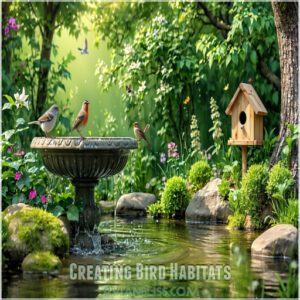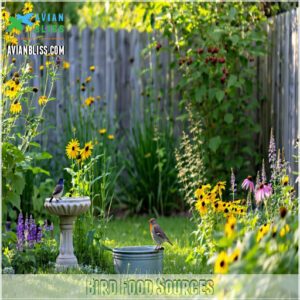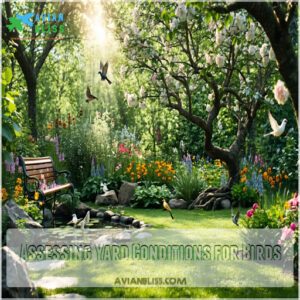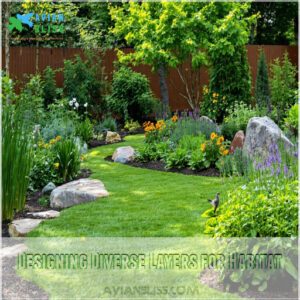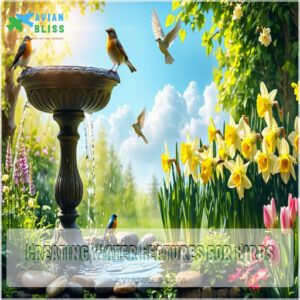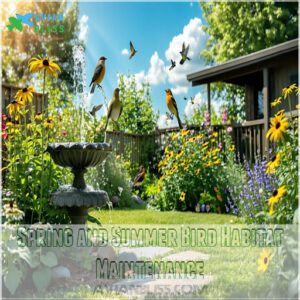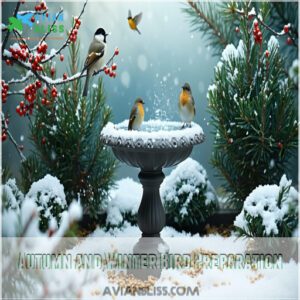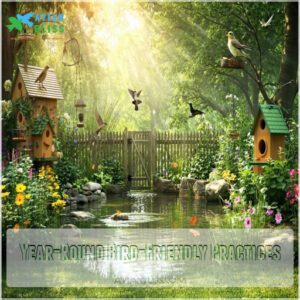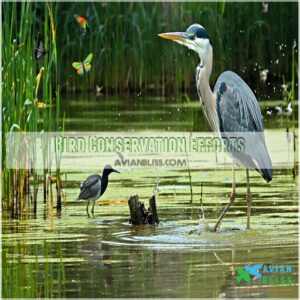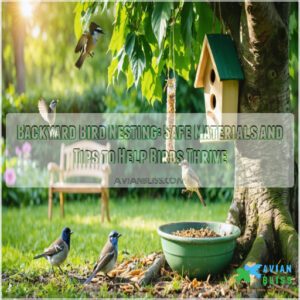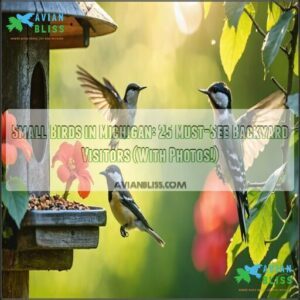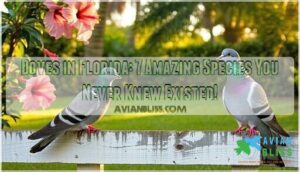This site is supported by our readers. We may earn a commission, at no cost to you, if you purchase through links.
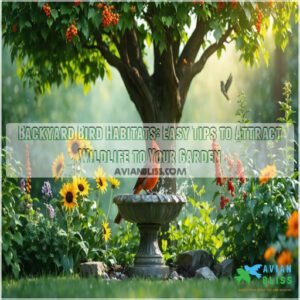
Start with native plants like oak trees and berry-producing shrubs that naturally attract insects and provide food sources. Create layers of vegetation where birds can nest and hide from predators.
Add features like sunflowers and coneflowers for seeds, while cardinal flowers and salvias attract hummingbirds.
Remember, you’re not just building a garden – you’re creating nature’s bed and breakfast. The right combination of plants can turn your space into a year-round sanctuary that supports local biodiversity.
Table Of Contents
- Key Takeaways
- Creating Bird Habitats
- Bird Food Sources
- Bird Habitat Design
- Seasonal Bird Care
- Bird Conservation Efforts
- Frequently Asked Questions (FAQs)
- How do I make a bird habitat in my backyard?
- What is the best habitat for birds?
- Where do backyard birds go at night?
- What is a certified backyard habitat?
- How long until birds discover my new habitat?
- When is the best time to photograph backyard birds?
- Should I remove old nests from birdhouses?
- What noise levels are acceptable near bird habitats?
- Conclusion
Key Takeaways
- You’ll need to focus on three core elements – food through native plants and feeders, shelter through diverse vegetation layers, and water features like birdbaths or fountains to create a complete habitat.
- You’re most successful when you choose native plants, as they naturally attract insects that birds eat, provide berries and seeds for food, and offer appropriate shelter for nesting and protection.
- You’ll want to maintain your habitat year-round by cleaning feeders weekly, providing heated water sources in winter, and leaving fallen leaves as natural mulch to support insect life.
- You’re contributing to bird conservation when you transform your yard into a wildlife sanctuary, and you can enhance your impact by joining citizen science programs to track bird populations and patterns.
Creating Bird Habitats
You can create a thriving bird habitat by focusing on native plants and essential resources like food, water, and shelter.
Native trees and shrubs serve to attract birds and also support the insects they need to survive and raise their young.
Choosing Native Plants for Birds
Choosing native plants is a powerful way to foster a bird-friendly garden while supporting habitat restoration. Native species thrive in your local ecosystem and attract the insects birds eat.
For eco-gardening success:
- Plant native trees like oaks for caterpillars.
- Include native shrubs producing berries.
- Add wildflowers for pollinators.
- Favor seasonal plants for year-round bird-friendly habitats.
By incorporating native plants, you support bird food sources that attract various bird species to your garden.
Providing Food and Shelter
Providing food and shelter is key to attracting birds.
Native plants supply natural food sources, while shrubs create bird shelter and nesting sites.
Add bird feeders and baths to support foraging and roosting areas.
When selecting supplemental food sources, consider using products from reliable bird feeder options.
| Element | Purpose | Example |
|---|
Selecting Bird-Friendly Trees and Shrubs
Birds need more than just food—they need safe spaces to perch, nest, and rest.
Incorporating tree species and shrubs for birds provides key shelter.
Use native choices to support wildlife and urban landscaping efforts.
- Plant evergreen trees for year-round cover.
- Choose deciduous trees offering buds, fruit, and seasonal habitat.
- Add native shrubs like spicebush to attract birds with berries.
Bird Food Sources
To attract a variety of birds, focus on providing diverse, natural food sources in your yard.
Native plants that produce seeds, attract insects, or offer nectar are essential for supporting bird populations year-round.
Native Plants for Seed Production
Native plants like sunflowers, coneflowers, and native grasses are perfect for seed production, giving birds an essential food source.
Seed-bearing plants and berry-producing shrubs naturally attract birds, supporting plant diversity.
Wildflower seeds also play a role in seed dispersal, creating self-sustaining habitats.
By growing native shrubs and seed-rich plants, you’ll craft a bird-friendly garden bursting with life.
Understanding the importance of sunflower seed basics can help you create an ideal environment for the birds visiting your garden.
Insect-Attracting Plants for Birds
Insect-attracting plants are a lifeline for birds, providing caterpillars and other insects they depend on.
Native blooms like coneflower naturally draw pollinators, creating a bird-friendly buffet in your wildlife garden.
Unlike non-native choices, these plants sustain a rich habitat.
A yard dominated by native plants becomes a haven, ensuring birds thrive through abundant food sources and ecological balance.
By incorporating native plants that support native plant conservation, you can create a thriving ecosystem for birds and other wildlife.
Nectar-Rich Plants for Hummingbirds
Hummingbirds are nature’s acrobats, gracing gardens in search of nectar-rich flowers.
Boost their visits with these beautiful, bird-friendly choices:
- Cardinal flowers for vibrant red blooms.
- Flowering dogwood to support pollinator health year-round.
- Salvia for a long-lasting nectar source.
- Bee balm to fit diverse garden designs.
Pair these with hummingbird feeders for a complete haven.
Bird Habitat Design
Designing a bird-friendly habitat means planning your yard to meet birds’ needs for food, water, shelter, and nesting.
By incorporating varied plant layers and water features, you’ll create a thriving space that supports biodiversity and attracts a wide range of bird species.
Assessing Yard Conditions for Birds
Understanding your yard’s conditions is the first step in habitat creation. Check soil types, sunlight exposure, and microclimates to guide native plant choices. Does your yard get dry sun or soggy shade? Each spot offers potential for wildlife gardening.
A proper yard assessment helps shape bird habitats that work with nature, not against it, ensuring thriving native vegetation for wildlife.
By considering the right bird feeding options, you can create a welcoming environment for various bird species.
Designing Diverse Layers for Habitat
Think of your yard as a bird apartment complex—design multiple habitat layers to create a bird-friendly haven.
Use native landscaping to mimic natural settings for bird diversity and ecosystem balance:
- Ground Cover: Low plants for insects and seeds.
- Shrubs: Mid-layer shelter and food.
- Canopy Trees: Roosting and nesting spots.
- Evergreens: Winter refuge.
- Brush Piles: Critical for cover.
Creating Water Features for Birds
Adding water features enhances your yard’s appeal for birds. Birdbaths, fountains, and ponds provide hydration and bathing spots while ensuring safety from predators. You can find a variety of bird bath fountain products online. Choose natural materials, like rocks and plants, for an inviting design.
| Feature | Benefits | Tip | Example |
|---|---|---|---|
| Birdbath Design | Drinking/Bathing | Keep shallow, clean | Store-bought birdbath |
| Pond Creation | Cooling/Nesting | Add plants/rocks | Small garden pond |
| Fountain Installation | Prevents stagnation | Use recirculating pump | Solar fountain |
| Water Quality | Safe access | Avoid chemicals | Aerated ponds |
Seasonal Bird Care
Caring for backyard birds throughout the year makes sure they’ve what they need for each season’s unique challenges.
By adjusting your garden’s habitat features seasonally, you’ll support bird survival and help sustain local populations.
Spring and Summer Bird Habitat Maintenance
Spring calls for bird-friendly gardening tips to improve habitat renewal. Focus your seasonal care on:
- Pest Control: Avoid chemicals; let natural predators thrive.
- Soil Health: Add compost for nutrient-rich soil supporting native plants. Consider native plant species to support a thriving ecosystem.
- Water Conservation: Mulch soil and offer clean birdbaths.
Your efforts guarantee vibrant spring and summer gardens!
Autumn and Winter Bird Preparation
Summer’s warmth fades into autumn, signaling the perfect time to ready your backyard for winter birds.
Clean your feeders to prevent bird flu, and stock them with black oil sunflower seeds, safflower seeds, or peanuts – perfect for chickadees and finches.
Don’t forget water sources; heated birdbaths prevent dehydration during freezing days.
Plant winterberry, chokeberry, or beautyberry shrubs now, creating natural food sources that’ll sustain your feathered friends through winter.
Year-Round Bird-Friendly Practices
Beyond winter preparations, maintaining bird-friendly practices throughout the year helps create thriving backyard bird habitats.
You’ll want to clean nesting boxes monthly and sanitize feeders weekly to prevent disease spread.
During bird migration seasons, reduce artificial lighting at night.
Keep native plants flourishing year-round to support winter foraging, and participate in habitat restoration by leaving fallen leaves as natural mulch for insect life.
Bird Conservation Efforts
You’ll find that creating a bird-friendly backyard habitat does more than attract feathered visitors—it contributes to essential conservation efforts that protect declining bird populations.
By transforming your yard into a natural sanctuary with native plants and sustainable practices, you’re joining thousands of citizen scientists who collect valuable data about backyard birds.
This effort helps strengthen wildlife corridors in urban areas, creating vital links for birds and other wildlife to thrive in otherwise fragmented habitats.
Citizen Science Programs for Birds
Join the growing community of citizen scientists who transform their backyard bird watching into valuable research data.
Through programs like Cornell Lab of Ornithology’s FeederWatch and the Great Backyard Bird Count, you’ll contribute to essential bird monitoring initiatives.
These science projects have flourished since the first Christmas Bird Count in 1900, helping researchers track migration patterns, habitat changes, and population trends.
Your observations make a real difference in bird conservation efforts.
Community Involvement in Bird Conservation
Building on your citizen science data collection, you’ll find countless ways to strengthen bird conservation in your community.
Local Volunteer Programs and Bird Festivals connect you with Conservation Partners who share your passion.
Transform your neighborhood into a bird-friendly community by leading Neighborhood Initiatives – from organizing native plant swaps to helping others create Certified Wildlife Habitat spaces.
Together, we’re weaving a stronger safety net for our feathered friends.
Enhancing Biodiversity in Backyard Habitats
Your backyard can become a thriving hub of biodiversity through habitat restoration. By planting native species and creating wildlife corridors, you’ll transform your space into an urban ecology success story.
Consider implementing best practices for backyard bird conservation to maximize your impact. Mix different plant heights, add water features, and maintain chemical-free practices to support ecosystem services.
You’re not just helping birds – you’re building a complex web of life that strengthens bird conservation efforts across your community.
Frequently Asked Questions (FAQs)
How do I make a bird habitat in my backyard?
Create a welcoming space with native trees and shrubs for shelter.
Include water sources like birdbaths.
Add diverse native plants for food.
Install appropriate feeders.
You’ll soon attract feathered visitors.
What is the best habitat for birds?
Imagine a lush paradise where birds thrive! lush paradise
You’ll want native trees and shrubs for shelter, plenty of food sources like berries and seeds.
fresh water features, and diverse plant layers that create safe nesting spots.
Where do backyard birds go at night?
At night, your feathered friends tuck themselves away in dense shrubs, tree cavities, or birdhouses.
They’ll find cozy spots in evergreen branches, brush piles, or rock crevices for protection from predators.
What is a certified backyard habitat?
Just as nature grants its seal of approval, you’ll receive official recognition when your outdoor space meets specific criteria for wildlife-friendly features like food sources, water features, and shelter options through conservation programs.
How long until birds discover my new habitat?
You’ll likely spot birds within a few days to weeks after setting up your habitat. They’re curious creatures and will investigate new food sources.
2-3 months is the typical time needed to establish a regular bird community.
When is the best time to photograph backyard birds?
Early morning light creates perfect conditions for bird photography.
You’ll catch stunning shots between 6-9 AM when they’re less skittish and naturally lit.
Should I remove old nests from birdhouses?
You absolutely must clean out those birdhouses every fall!
Old nests harbor parasites that’ll drive birds crazy.
Remove them completely, scrub with a mild soap solution, and you’ll have happy birds returning each spring.
What noise levels are acceptable near bird habitats?
You’ll want to keep noise levels below 60 decibels, similar to normal conversation.
Birds can tolerate regular household sounds, but avoid sudden loud noises or prolonged disruptions that’ll stress them during nesting.
Conclusion
Creating backyard bird habitats isn’t just about beautifying your space—it’s about fostering life, promoting biodiversity, and becoming a steward of nature.
Whether you’re planting native species, installing water features, or setting up feeding stations, you’re building connections with local wildlife that will reward you year after year.
By transforming your yard into a vibrant sanctuary, you’re supporting bird populations but also serves to create a living legacy that future generations can enjoy and learn from.
- https://www.audubon.org/news/how-make-your-yard-bird-friendly-0
- https://www.bhg.com/gardening/design/nature-lovers/create-a-backyard-wildlife-habitat/
- https://www.birdsandblooms.com/birding/attracting-birds/plants-and-trees-that-attract-birds/bird-habitat/
- https://columbialandtrust.org/
- https://birdallianceoregon.org/

